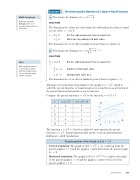Page 792 - Algebra 1
P. 792
Determining the Domain of a Square-Root Function
a. Determine the domain of y = √ x - 4. SOLUTION
The domain is the values for x that make the radicand greater than or equal to zero. Solve x - 4 ≥ 0.
x - 4 ≥ 0 Set the radicand greater than or equal to 0. x ≥ 4 Solve for x by adding 4 to both sides.
The domain is the set of all real numbers greater than or equal to 4.
_ x
b. Determine the domain of y = 3√ + 4 - 7.
Example
2
Math Language
Remember that the domain is the set of possible input values for a function.
SOLUTION
_x + 4 ≥ 0 2
_x ≥ -4 2
2
Set the radicand greater than or equal to 0.
Subtract 4 from both sides. Multiply both sides by 2.
Hint
When graphing square- root functions, always plot the smallest value for x so that the graph will be complete.
x ≥ -8
The domain is the set of all real numbers greater than or equal to -8.
All square-root functions look similar to the graph of y = √x, which is
called the parent function. A transformation of a function is an alteration of the parent function that produces a new function.
Compare the parent function y = √x to the function y = √x + 3.
x
y = √ x
y = √ x + 3
0
0
3
1
1
4
4
2
5
9
3
6
16
4
7
y
6
4
2
y = √x
O
x
4
8
1
2
1
6
The function y = √x + 3 has been shifted 3 units up from the parent function y = √x. Transformations that involve vertical and horizontal
shifting are called translations.
Transformations of the Graph of f(x) = √x
Vertical translation: The graph of f(x) = √x + c is c units up from the parent graph if c > 0 and the graph is c units down from the parent graph if c < 0.
Horizontal translation: The graph of f(x) = √x - c is c units to the right
of the parent graph if c > 0 and the graph is c units to the left of the parent graph if c < 0.
Lesson 114 777
y = √x + 3


